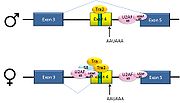
Doublesex
Encyclopedia

Gene
A gene is a molecular unit of heredity of a living organism. It is a name given to some stretches of DNA and RNA that code for a type of protein or for an RNA chain that has a function in the organism. Living beings depend on genes, as they specify all proteins and functional RNA chains...
that is involved in the sex determination system of the fruit fly Drosophila melanogaster
Drosophila melanogaster
Drosophila melanogaster is a species of Diptera, or the order of flies, in the family Drosophilidae. The species is known generally as the common fruit fly or vinegar fly. Starting from Charles W...
.
Sex determination
The gene is expressedGene expression
Gene expression is the process by which information from a gene is used in the synthesis of a functional gene product. These products are often proteins, but in non-protein coding genes such as ribosomal RNA , transfer RNA or small nuclear RNA genes, the product is a functional RNA...
in both male and female flies and is subject to alternative splicing
Alternative splicing
Alternative splicing is a process by which the exons of the RNA produced by transcription of a gene are reconnected in multiple ways during RNA splicing...
, producing the protein isoform
Protein isoform
A protein isoform is any of several different forms of the same protein. Different forms of a protein may be produced from related genes, or may arise from the same gene by alternative splicing. A large number of isoforms are caused by single-nucleotide polymorphisms or SNPs, small genetic...
s dsxf in females and the longer dsxm in males. The production of dsxf is caused by the presence of the female-specific version of the transformer (tra) gene.
In a sense, the isoform of dsx informs a cell about the organism's sex; for instance, female genitals only develop if dsxf is present. In conjunction with the gene fruitless
Fruitless (gene)
The fruitless gene is a Drosophila melanogaster gene that encodes several variants of a putative transcription factor protein. Normal fruitless function is required for proper development of several anatomical structures necessary for courtship, including motor neurons which innervate muscles...
, dsx also causes differences in the brain structure and behavior of males and females.
Although the details of sex determination differ in the various species, there is a gene related to dsx in vertebrate
Vertebrate
Vertebrates are animals that are members of the subphylum Vertebrata . Vertebrates are the largest group of chordates, with currently about 58,000 species described. Vertebrates include the jawless fishes, bony fishes, sharks and rays, amphibians, reptiles, mammals, and birds...
s (DMRT1
DMRT1
Doublesex and mab-3 related transcription factor 1, also known as DMRT1, is a protein which in humans is encoded by the DMRT1 gene.- Function :...
) and in nematode
Nematode
The nematodes or roundworms are the most diverse phylum of pseudocoelomates, and one of the most diverse of all animals. Nematode species are very difficult to distinguish; over 28,000 have been described, of which over 16,000 are parasitic. It has been estimated that the total number of nematode...
s (MAB-3). All of these are transcription factor
Transcription factor
In molecular biology and genetics, a transcription factor is a protein that binds to specific DNA sequences, thereby controlling the flow of genetic information from DNA to mRNA...
s with a zinc finger
Zinc finger
Zinc fingers are small protein structural motifs that can coordinate one or more zinc ions to help stabilize their folds. They can be classified into several different structural families and typically function as interaction modules that bind DNA, RNA, proteins, or small molecules...
DNA-binding domain
DNA-binding domain
A DNA-binding domain is an independently folded protein domain that contains at least one motif that recognizes double- or single-stranded DNA. A DBD can recognize a specific DNA sequence or have a general affinity to DNA...
(known as the DM domain
DM domain
In molecular biology the DM domain is a protein domain first discovered in the doublesex proteins of Drosophila melanogaster and is also seen in proteins from Caenorhabditis elegans. In D. melanogaster the doublesex gene controls somatic sexual differentiation by producing alternatively spliced...
) and are involved in sex-specific differentiation.

